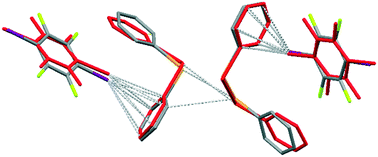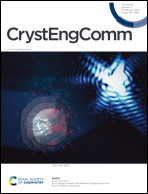Long-range supramolecular synthon polymorphism: a case study of two new polymorphic cocrystals of Ph2Te2–1,4-C6F4I2†
Abstract
Along with the reported earlier cocrystal of diphenyl ditelluride (Ph2Te2) and halogen bond donor 1,4-diiodo-tetrafluorobenzene (p-DITFB) 1α, its two new polymorphic forms (1β and 1γ) present a rare case of long-range supramolecular synthon module polymorphism. In contrast to I⋯Te halogen bonding (HaB) in the earlier reported form 1α, their main building motif is I⋯π(Ph) HaB. The lattice energy calculations for this polymorphic triad suggest the 1α–1β–1γ sequence from the kinetic to thermodynamic form. Cocrystal 1β appeared completely isostructural with the Ph2Se2·(p-DITFB) cocrystal and the double chains of Ph2Te2 molecules in 1β reproduce the packing of the pure Ph2Se2 and the pattern of Ph2Se2 chains in Ph2Se2·p-DITFB. Single chains of Ph2Te2 in the 1γ form feature only partial similarity with 1β but together, these three polymorphic cocrystals along with the native Ph2Te2 and Ph2Se2 compose a rather detailed and remarkable structural landscape. It suggests the putative polymorphic forms of Ph2Te2 and Ph2Se2, which were studied in silico by periodic DFT. The energy framework approach appeared to be a useful and illustrative way to analyze the correlation between the energetic structure of co-crystals 1β and 1γ and their noticeably different habits.



 Please wait while we load your content...
Please wait while we load your content...